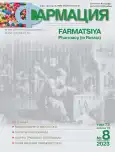Development of a method for the quantitative determination of flavonoids in dill herb (Anethum graveolentis herba)
- Authors: Bourakba S.1, Marakhova A.I.1, Zhilkina V.Y.1, Bokov D.O.2,3
-
Affiliations:
- Russian Peoples' Friendship University (RUDN)
- I.M. Sechenov First Moscow State Medical University (Sechenov University)
- Federal Research Center for Nutrition and Biotechnology
- Issue: Vol 72, No 8 (2023)
- Pages: 45-49
- Section: Technology of medicines
- URL: https://journals.eco-vector.com/0367-3014/article/view/625596
- DOI: https://doi.org/10.29296/25419218-2023-08-07
- ID: 625596
Cite item
Abstract
Introduction. The dill herb, collected before flowering, contains a complex of various biologically active compounds (BACs) and can act as an independent medicinal plant material. There is data confirming the activity of the aerial part of dill against Agrobacterium radiobacter pv. Tumefaciens, Erwinia carotovora, Pseudomonas fluorescens, Pseudomonas wisteria. The antimicrobial properties of the herb dill may be associated with the presence of phenolic compounds, including flavonoids, in the chemical composition, so the quantitative determination of the amount of these biologically active compounds is relevant.
Purpose of the work: to develop a method for quantitative determination of the amount of flavonoids in dill herb (Anethum graveolentis herba).
Material and methods. The object of study was air-dried dill herb (Anethum graveolens L.), harvested before flowering. Quantitative determination of the amount of flavonoids was carried out by spectrophotometric method after complexation reaction with aluminum chloride on a Lambda-950 spectrophotometer, Perkin Elmer, USA.
Results and discussion. As a result of the study, it was shown that to determine the amount of flavonoids in aromatic dill herb harvested before flowering, the following conditions are optimal: crushing of raw materials to a particle size of 1 mm, mass of raw materials about 2 g, extraction with 80% ethyl alcohol in a volume of 100 ml when heated for 50 min; the ratio of the volume of the extract and 2% aluminum chloride solution is 1:1, the complexation reaction time is 30 minutes.
Conclusion. A method has been developed for determining the amount of flavonoids in terms of rutin and absolutely dry raw materials in dill herb (Anethum graveolentis herba).
Keywords
Full Text
About the authors
Safa Bourakba
Russian Peoples' Friendship University (RUDN)
Author for correspondence.
Email: bourakba_s@pfur.ru
ORCID iD: 0009-0009-4421-5373
PhD Student, Institute of Biochemical Technology and Nanotechnology
Russian Federation, st. Miklouho-Maklaya, 6, Moscow, 117198Anna Igorevna Marakhova
Russian Peoples' Friendship University (RUDN)
Email: agentcat85@mail.ru
ORCID iD: 0000-0003-4442-9266
Dr. Pharm. Sci., Professor, Institute of Biochemical Technology and Nanotechnology
Russian Federation, st. Miklouho-Maklaya, 6, Moscow, 117198Vera Yuryevna Zhilkina
Russian Peoples' Friendship University (RUDN)
Email: zhylkina_vyu@pfur.ru
ORCID iD: 0000-0001-7916-5913
Candidate of Pharmaceutical Sciences, Associate Professor of the Institute of Biochemical Technology
Russian Federation, st. Miklouho-Maklaya, 6, Moscow, 117198Dmitry Olegovich Bokov
I.M. Sechenov First Moscow State Medical University (Sechenov University); Federal Research Center for Nutrition and Biotechnology
Email: bokov_d_o@staff.sechenov.ru
ORCID iD: 0000-0003-2968-2466
Candidate of Pharmaceutical Sciences, Associate Professor, Associate Professor of the Department of Pharmaceutical Natural Sciences of the Institute of Pharmacy named after A.P. Nelyubin; researcher at the Laboratory of Food Chemistry
Russian Federation, st. Trubetskaya, 8, building 2, Moscow, 119991; Ustinsky proezd, 2/14, Moscow, 109240References
- GOST 32856–2014 «Ukrop svezhij. Tekhnicheskie usloviya Fresh dill. Specifications» Data vvedeniya. 2016–01–01 (in Russian).
- Kusova R.D., Kabaloeva K.M., Atlaskirova S.A., Kabaloev Z.V. Standartizaciya plodov fenhelya obyknovennogo, vhodyashchegov sostav lekarstvennogo sbora, primenyaemogo pri zabolevaniyah organov dyhaniya. Materialy X Mezhdunarodnoj studencheskoj nauchnoj konferencii «Studencheskij nauchnyj forum» URL: https://scienceforum.ru/2018/article/2018009245' target='_blank'>https://scienceforum.ru/2018/article/2018009245">https://scienceforum.ru/2018/article/2018009245 (data obrashcheniya: 16.03.2023 ) (in Russian).
- Kislichenko V.S., Terninko I.I. Dinamika nakopleniya otdel'nyh grupp bav v syr'e fenhelya obyknovennogo. Ukrainskij medicinskij al'manah. 2011; 14 (4): 53–4 (in Russian).
- Terninko I.I., Onishchenko U.E. Kislichenko V.S. Opredelenie kolichestvennogo soderzhaniya flavonoidov v nadzemnyh chastyah otdel'nyh predstavitelej semejstva Sel'derejnyh. Farmacevticheskij zhurnal. 2009; 4: 11–5 (in Russian).
- Barros L., Sandrina A., Carvalho M., and Ferreira I.. Systematic evaluation of the antioxidant potential of different parts of Foeniculum vulgare Mill. from Portugal. Food Chem Toxicol. 2009; 47 (10): 2458–64. doi: 10.1016/j.fct.2009.07.003.
- Rahami R., Ardekani M. Medicinal properties of Foeniculum vulgare Mill. In traditional Iranian medicine and modern phytotherapy. Chinese J. of Integrative Medicine. 2013; 19 (1): 73–9. doi: 10.1007/s11655-013-1327-0.
- Roby M., Sarhan M., Selim K., Khalel K. Antioxidant and antimicrobial activities of essential oil and extracts of fennel (Foeniculum vulgare L.) and chamomile (Matricaria chamomilla L.). Industrial Crops and Products. 2013; 44: 437–45.
- Singh G., Maurya S., Catalan C. Chemical constituents, antifungal and antioxidative potential of Foeniculum vulgare volatile oil and its acetone extract. Food Control. 2006; 17 (9): 745–52 https://doi.org/10.1016/j.foodcont.2005.03.010.
- Kurkina A.V. Flavonoidy farmakopejnyh rastenij: rekomendovano Central'nym koordinacionnym metodicheskim sovetom GBOU VPO SamGMU Minzdravsocrazvitiya Rossii. Samara : Obshchestvo s ogranichennoj otvetstvennost'yu "Ofort", 2012; 290. ISBN 978-5-473-00803-6. – EDN UCPGGZ (in Russian).
Supplementary files






